The Gemology of Emeralds
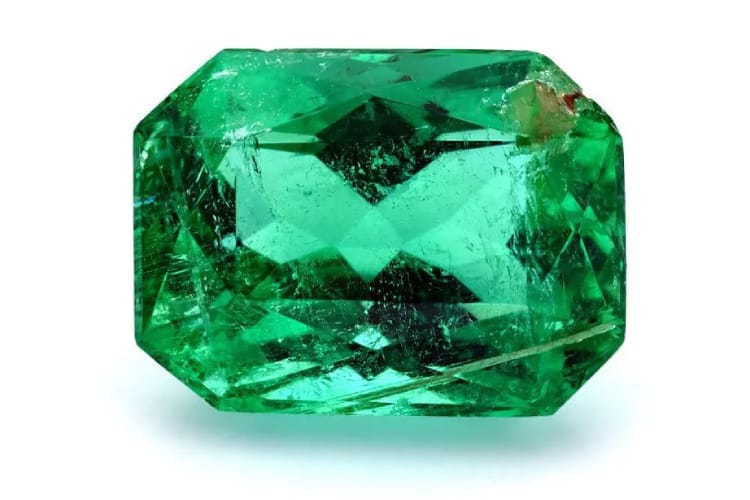
Emerald has been synonymous with the color green since ancient times. A fine emerald is a truly breathtaking sight, and this member of the beryl family deserves its placement among the traditional “Big Four” gems along with diamond, ruby, and sapphire. Colombian emeralds command the highest prices – sometimes $100,000 a carat or more depending on size and color – while recent emerald discoveries in Ethiopia and Brazil are also seeing high prices.
Emeralds have fascinated people since ancient times. Not surprisingly, cultures from all over the world have developed a rich folklore around emeralds, and stories of famous emeralds have captivated people for centuries. Emerald is also the birthstone for May as well as the 20th and 35th wedding anniversary stone.
Like many stones, the per-carat price of fine quality emerald escalates rapidly with size. For example, a recent price guide lists a fine quality 3-ct Colombian stone as six times more valuable than three equivalent quality 1-ct stones.
Value factors hinge largely on color, with nuances of saturation and hue affecting price to a significant degree. The most desirable color is a slightly bluish green in a medium dark tone with strong to vivid saturation.
Clarity is important, but inclusions are tolerated more in emeralds than virtually any other gem. Top quality, unenhanced stones (with certification) can bring as much as 50% more in price than treated stones of the same size, color, and clarity.
What Causes Emerald Color?
Emerald is a medium or darker green to blue-green beryl gemstone, in which the green color is derived from impurities of chromium (Cr), vanadium (V), or a combination of both. Before 1963, the definition of emerald was limited to beryls with chromium impurities, but the discovery in Brazil of a large deposit of beryl stones colored green by vanadium led to modification. According to the modern definition, the purity and saturation of the green color of a beryl is what defines an emerald.
Varying amounts of iron (Fe) will affect the color as well. More iron atoms increase the bluish tones.
Are All Green Beryls Emeralds?
In a situation similar to the division between pink sapphire and ruby, some chromium colored stones of light to medium-light green color are sometimes sold as emeralds though they could be considered green beryls. Emeralds should have a medium to dark primary green hue. (Editor’s note: Some gemologists, including Dr. Joel Arem, define emerald strictly as beryl that contains chromium and consider beryls colored green because of vanadium to be simply green beryls).
Do Emerald Colors Vary by Locality?
Geological conditions in Colombia produced exactly the slightly bluish-green shade and strong saturation that make stones from that locale the epitome of the variety. Emeralds from the Muzo and Chivor mines in Colombia can be distinguished in a general way. Muzo material is yellowish green, whereas that from Chivor is blue-green. (It sometimes takes a trained eye to see the distinction in color, however).
Emeralds from Zambia may also display an unusual blue tone, with blue-green/yellow green pleochroism, due to their high iron content (0.73%). Zambian crystals may be intensely color zoned, with near colorless cores and dark green rims, almost like watermelon tourmaline.
Relatively recently discovered emeralds from Itabira, Minas Gerais, Brazil, rival the best Colombian stones in quality. They are typically light bluish green down the c-axis.
Where are the Major Sources of Emeralds?
The center of world emerald mining is in South America, with Colombia and Brazil as major producers.
The Egyptian mines that supplied Cleopatra’s passion have long since been played out. However, today the African continent is second only to South America in production, with mines in Zambia, Zimbabwe, Madagascar, and Nigeria. Each of these locales typically produces a certain color, size, and clarity. Since 2016, Ethiopia has also produced some high-quality emeralds with grass green to blue-green colors that don’t need oil treatments. Other notable sources of emeralds include Afghanistan and China.
As for consumers, the United States and Japan together purchase more than 75% of the world’s cut emeralds.
Identifying Characteristics
The physical and optical properties of emeralds may help gemologists distinguish natural from synthetic stones and even identify the sources of mined stones.
Absorption Spectrum
The absorption spectrum of emerald is very distinctive, with fine lines in the red, weak ones in the blue, and broad absorption in the violet; e and o have different characteristics:
- o: 6830/6800 doublet plus 6370 line; broad band 6250-5800; narrow lines 4775 and 4725.
- e: 6830/6800 doublet, very strong; no 6370 line, but see diffuse 6620 and 6460 lines; broad absorption band is weaker, no lines visible in the blue at all.
Some Zambian emeralds contain Fe and display the spectral lines of aquamarine as well as emerald. Pleochroism in these gems is also distinctive: blue/yellowish-green. Vanadium-bearing emeralds may show a weak band at 6100.
Luminescence
The luminescence of emerald is very distinctive and can help positively identify an emerald.
- Natural, untreated emeralds: Usually inert, weak orange red to red, ultraviolet (UV) longwave (LW) and shortwave (SW).
- Oil in emeralds: Moderate yellow green LW, weaker in SW.
Iron in emeralds may quench fluorescence.
Inclusions
Emeralds can feature many kinds of internal fractures and inclusions. The evocative term jardin, French for “garden,” is used to refer to this variety. The types of inclusions in emeralds can help identify their sources. See the tables below.
Emerald Properties by Source
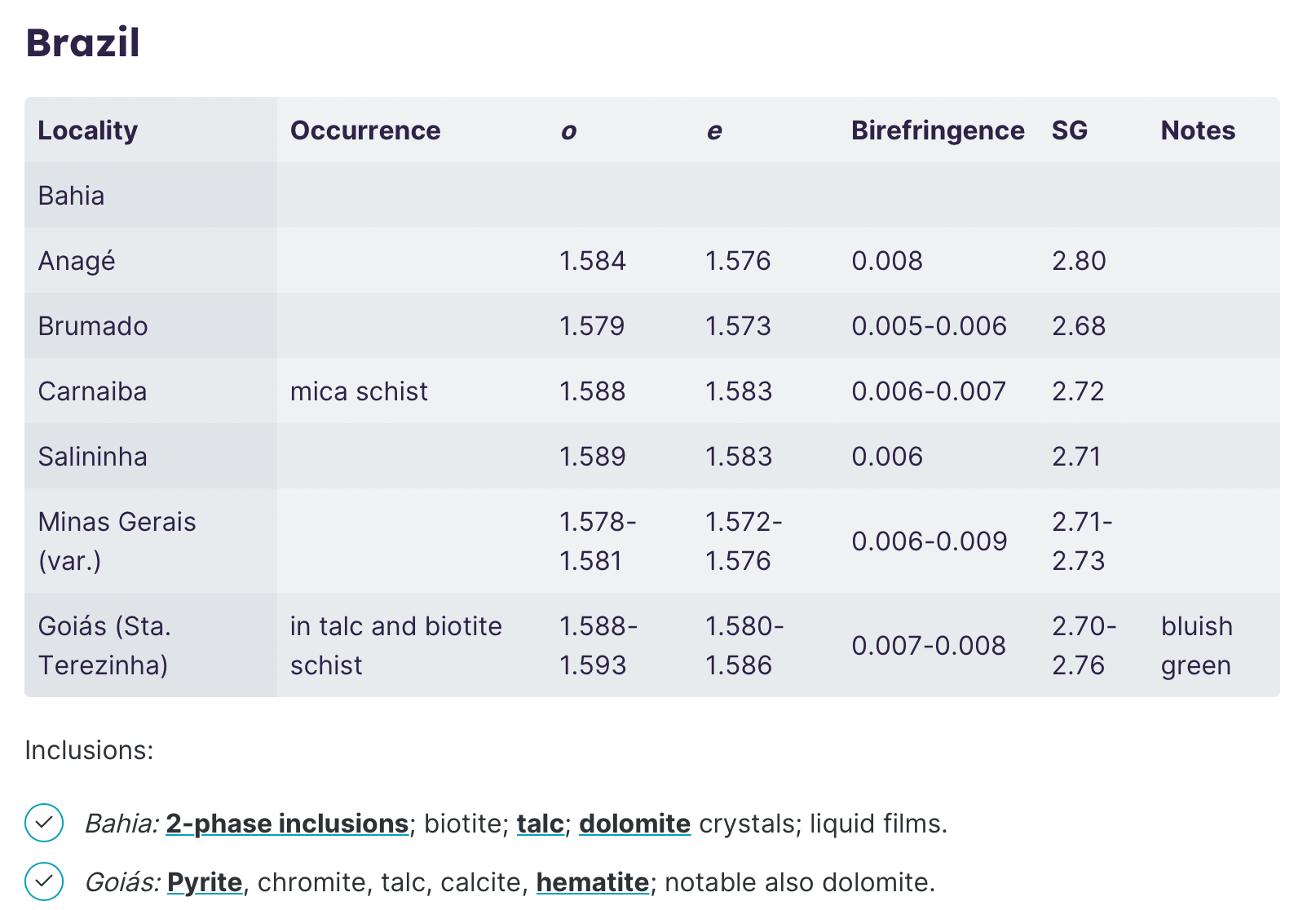
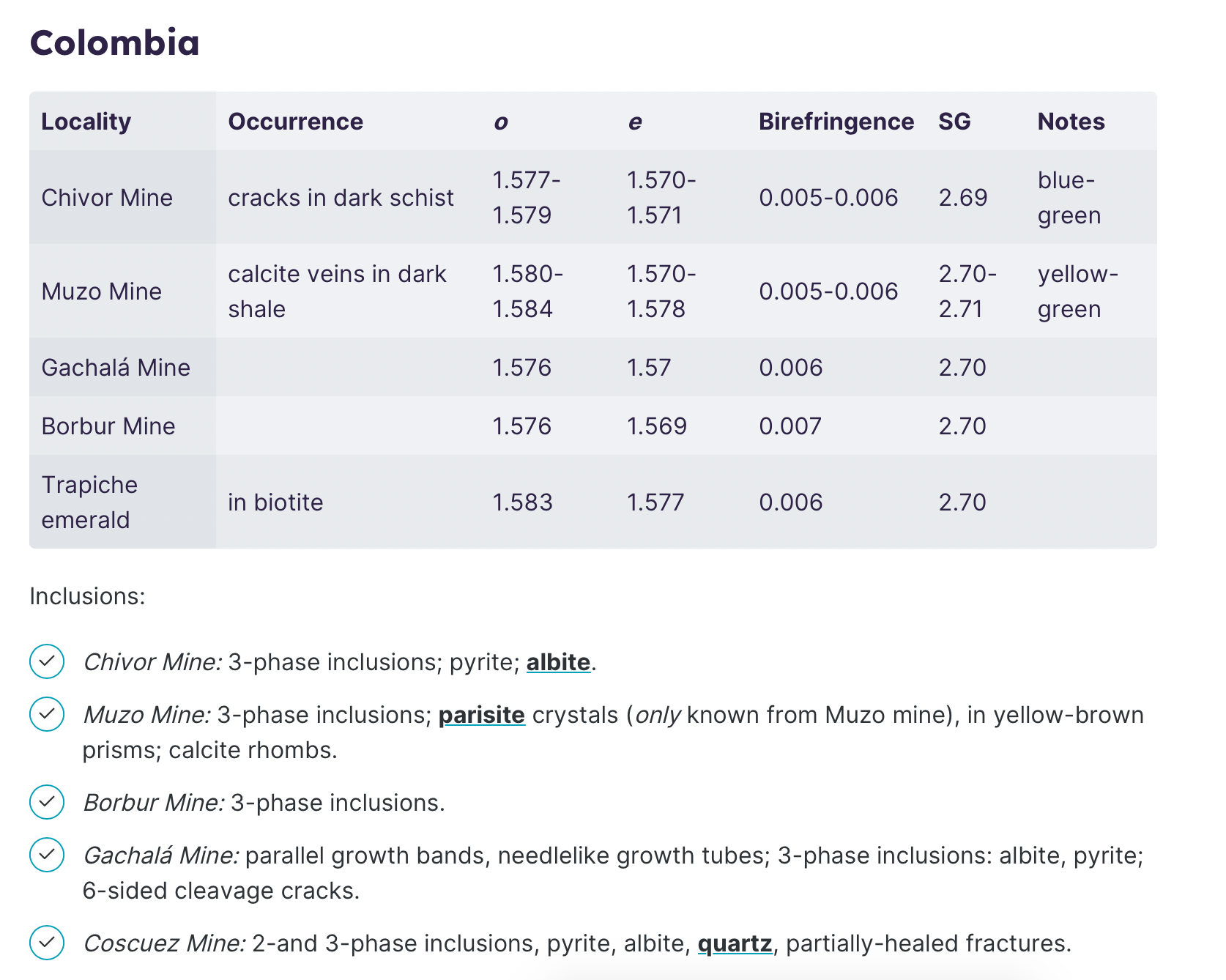
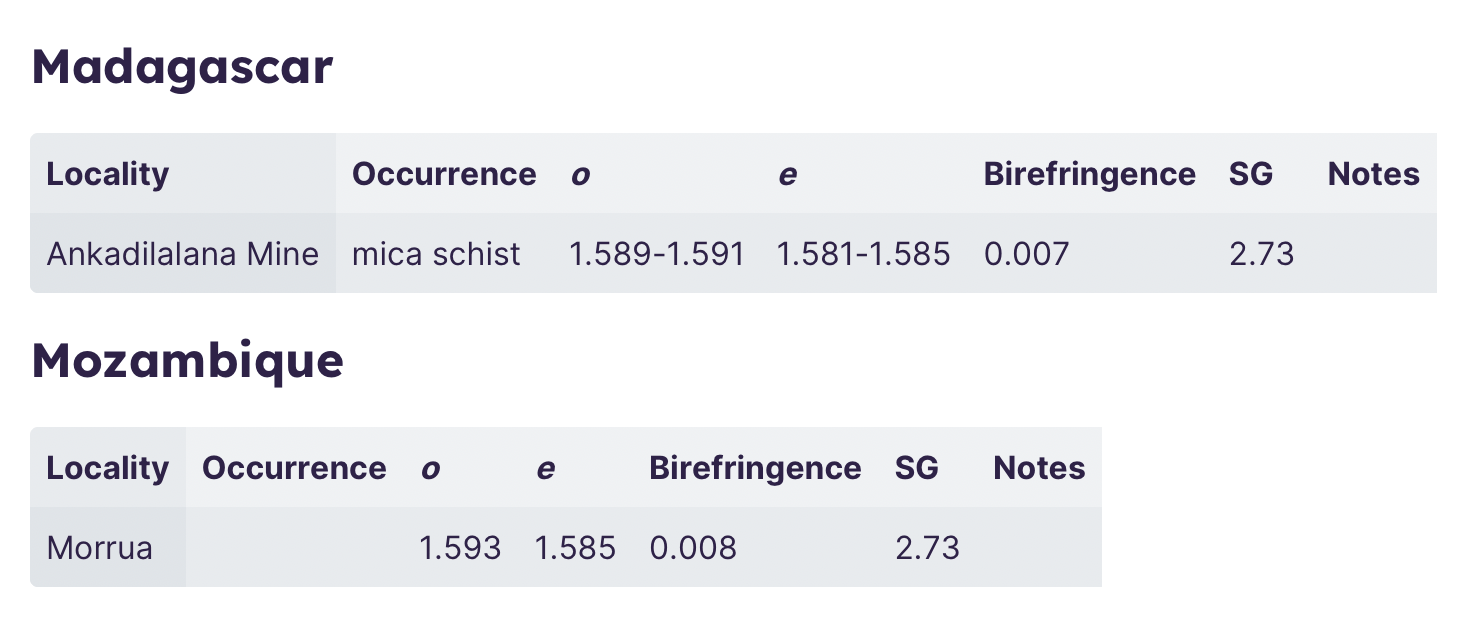
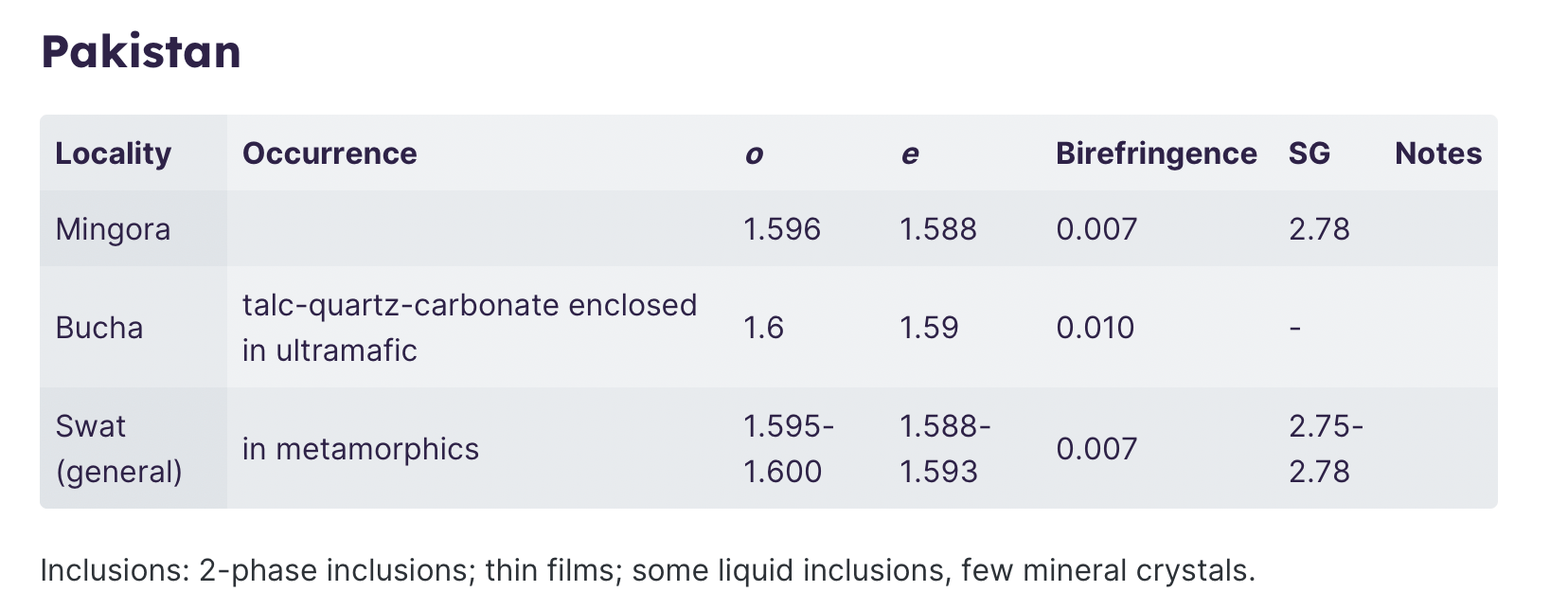

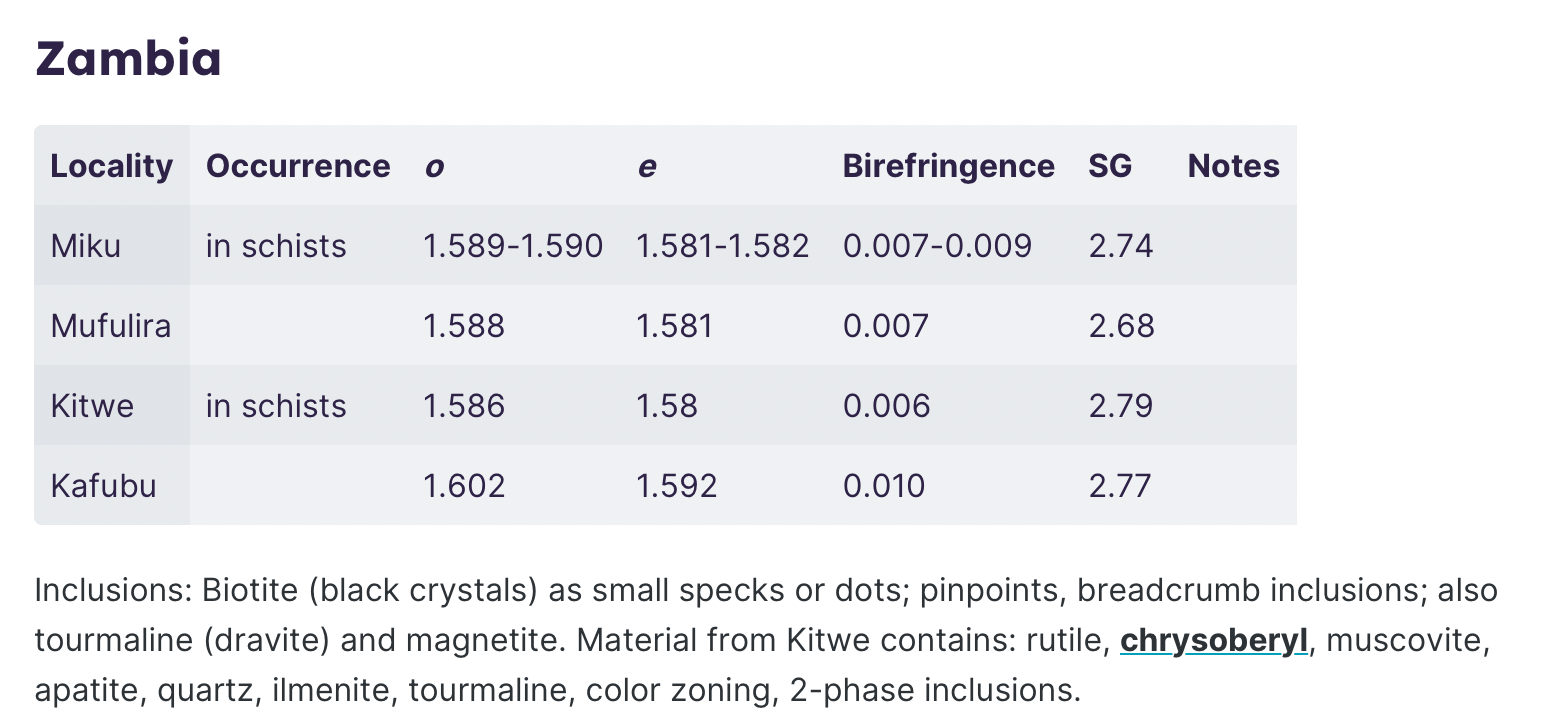
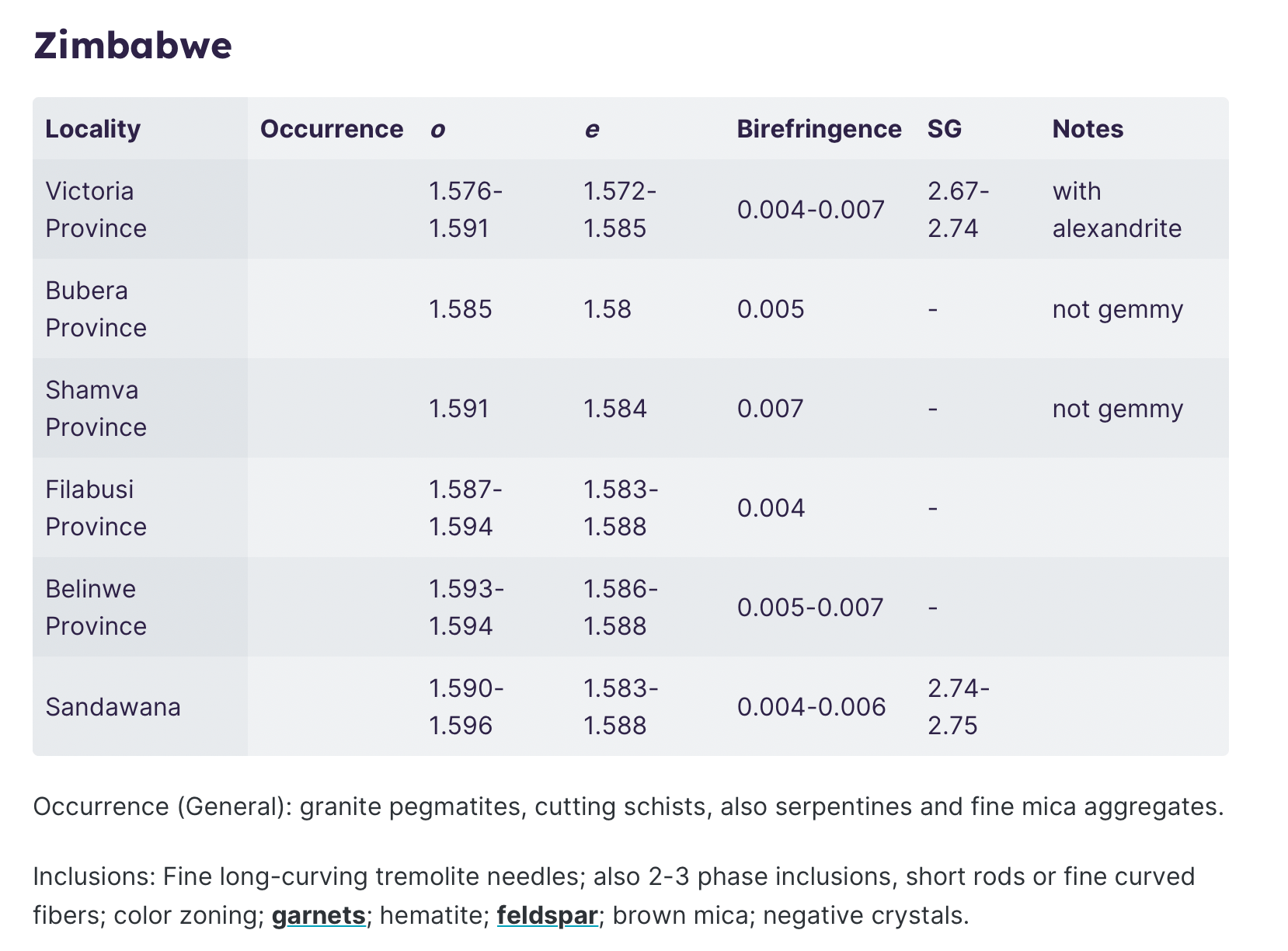
Emerald Simulants
Emerald simulants or imitations often encountered in the marketplace include: glass, yttrium aluminum garnet (YAG), green cubic zirconia (CZ), and assembled triplets of beryl as well as synthetic spinel. Although these pieces may resemble emeralds, their optical and physical properties differ notably from those of emeralds.
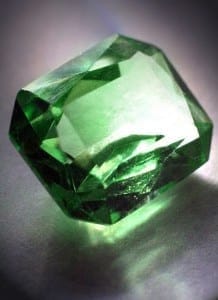
A glass imitation of emerald. Photo by Michelle Tribe. Licensed under CC By 2.0.
Of course, other natural green gemstones may also resemble emeralds and may be misidentified — either accidentally or deliberately — as emeralds. Since emeralds are among the most popular and expensive gemstones in the world, unscrupulous vendors may associate the name “emerald” to other less popular green gems in order to drum up consumer interest, such as calling green fluorite “African emerald” or chrome sphene “Mexican emerald.” However, gemologists can usually readily distinguish emeralds from other gemstones.
Lab-Created Emeralds
Two major processes, the hydrothermal and flux methods, can produce laqb-grown or lab-created emeralds.
If you’ve seen and priced created emeralds, you may wonder why they’re so costly compared to other lab grown gem, such as lab-grown sapphires. Both the hydrothermal and flux methods of production require costly equipment and are energy intensive. They take a long time to produce emeralds and have a low yield of cuttable gems.
Comparison of Natural and Lab-Grown Emerald Properties
Lab-grown emeralds typically have slightly lower refractive indices (RI) and birefringence than do natural stones. Most lab-grown emeralds have the same absorption spectrum as natural emeralds. Gilson type III may have a line at 4270.
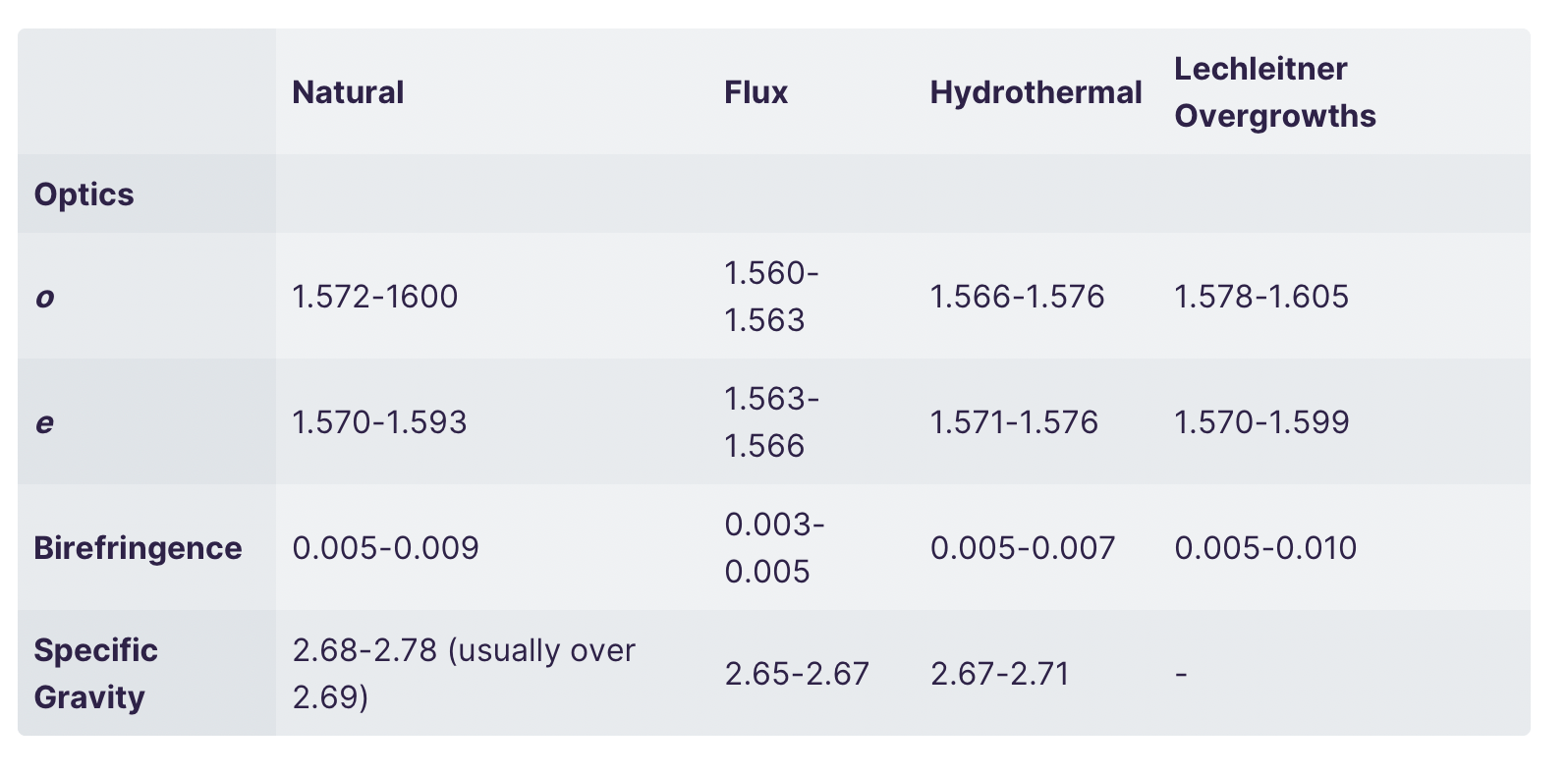
Flux-Grown Characteristics
Flux-grown emerald doesn’t show the infrared spectrum characteristics of water in the beryl structure. This spectrum is characteristic only of natural and hydrothermal lab-grown emeralds. Flux-grown emeralds typically have relatively low RIs and specific gravity values (SG) and show strong red fluorescence in UV.
Trace Elements
Chlorine appears to be a diagnostic trace element found only in hydrothermal synthetics. Other trace elements overlap with natural material and are therefore not diagnostic. Natural emeralds contain Na, Mg, and Fe in significantly higher amounts (more than 0.1%) than lab-grown emeralds but contain lower amounts (less than 18%) of silica and alumina.
Luminescence in Lab-Created Emeralds
- Chatham flux grown emerald: Weak to moderate red-brown and red, LW and SW.
- Gilson flux grown emerald: Usually weak to moderate red, stronger in LW, some weak to moderate yellow, yellow green, or orange, LW and SW. Dull red in X-ray.
- Gilson type III created emerald: Inert.
- Zerfass: Weak red in LW.
- Regency (Linde): Bright red in LW.
- Biron: Inert.
- Crystal Research: Inert.
- Lenix: Red in LW.
- Seiko: Green (distinctive) in LW.
- Russian lab-grown emerald: Weak to moderate orangish red LW, inert SW.
- Hydrothermal created emerald: Moderate to strong red, LW and SW, some inert.
Chatham stones transmit UV to 2300, whereas natural emeralds are opaque below 3000.
Regency emerald is the material formerly made by Linde, manufactured under license by Vacuum Ventures, Inc. This material is therefore identical with the Linde product.
Inclusions of Lab-Grown Emeralds
Some of the first lab-created emeralds on the market weren’t convincing because they were so clean. However, the sophistication of today’s consumer has led to a trend toward more natural-looking lab-created emeralds with inclusions. Although this improves their salability, it makes a little more difficult for gemologists and appraisers to prove natural origin. Fortunately, the types of inclusions in lab-created emeralds can help gemologists verify either a mined or synthetic origin.
Flux-Grown Inclusions
Flux grown emeralds may contain flux, platinum crystals, (metallic) phenakite crystals (colorless and low relief) and show a Venetian blind effect.
- Gilson: Veil-like feathers.
- Lenix: Flux particles; 2-phase inclusions resembling feathers.
- Russian: Flux-void fillings and healed fractures (orangey brown).
- Seiko: Flux inclusions, concentrated in a plane between color zones; strong color zoning; Starburst inclusions; dust-like flux, seemingly at surface of gem but actually inside the stone.
- I.G. Farben/Zerfass: Phenakite inclusions; profuse twisted veils.
- Chatham: Fingerprint veils; phenakite crystals; flux inclusions.
Hydrothermal Inclusions
- Regency (Linde): Portions of seed crystals; phenakite crystals; dagger-like inclusions (nail heads); flattened healed cracks, with 2-phase inclusions visible (high magnification); pointed hollow tubes.
- Lechleitner: Parallel color bands; dust-like particles; wedge-shaped 2-phase inclusions parallel to growth direction; octagonal gold crystals.
- Biron: Fingerprints; veils; fractures; nail heads with liquid and gas; large 2-phase inclusions; white comet tails; gold particles; phenakite; growth features.
- Crystal Research: 2-phase inclusions; color banding (in early material).
- Inamori: 2-phase inclusions.
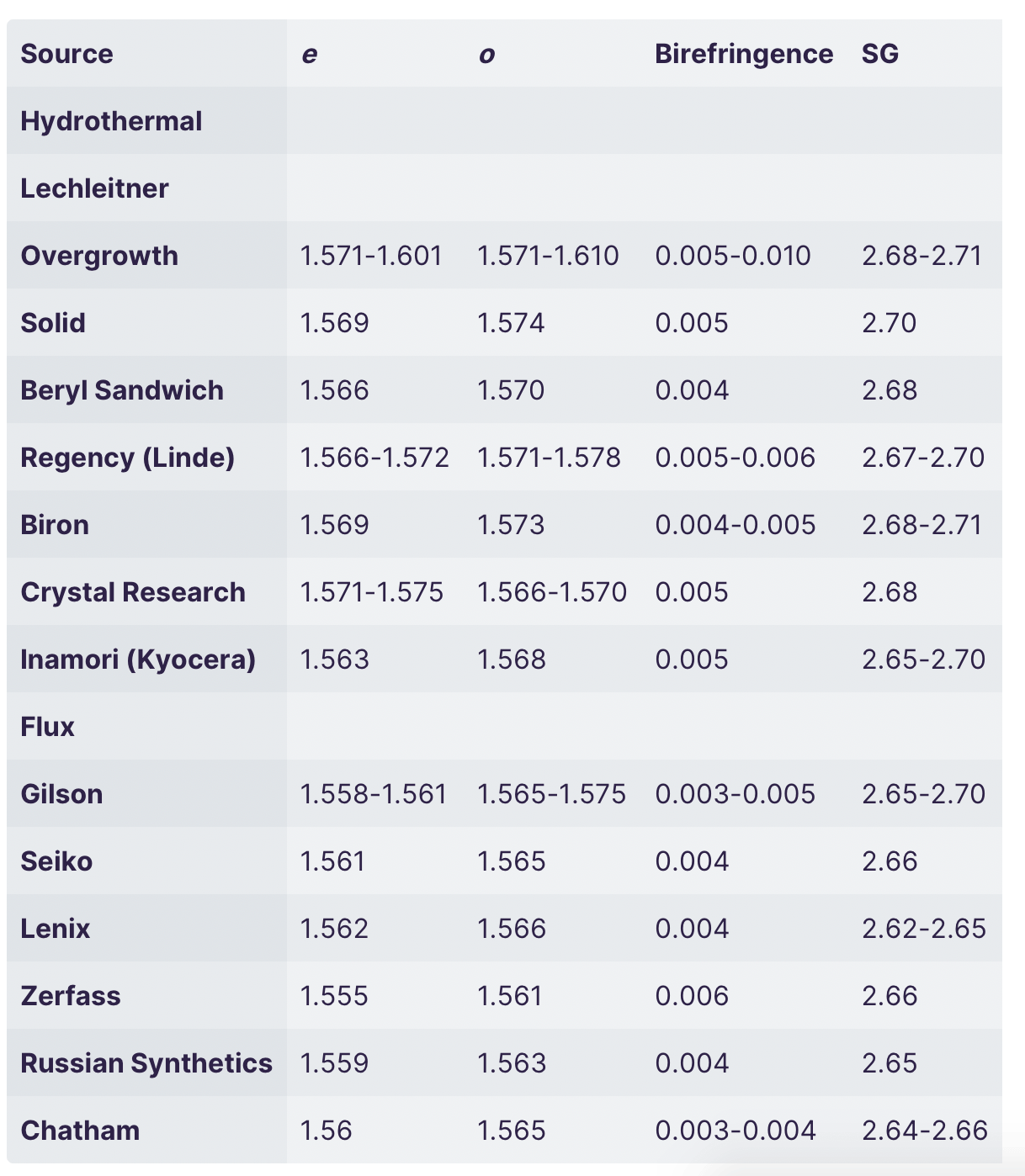
Emerald Enhancements
Emerald is considered a “Type III” gemstone, which means these gems are virtually always included to some degree. Because of this designation, a clarity grade of “Very Slightly Included” is the normal range for emeralds. Well over 90% of the emeralds in commerce have been treated to minimize the appearance of the inclusions.
Emerald inclusions pose more than aesthetic considerations, however. Although emeralds, like other beryls, have a high hardness rating, they’re more fragile than other beryls. (A high Mohs rating doesn’t mean a stone is indestructible. It simply means the stone is more resistant to scratching). Their inclusions reduce their structural integrity, and these inclusions occur because of how emeralds form under the Earth. They’re unavoidable. Emerald enthusiasts will simply have to treat these gems gently.
The standard industry practice for enhancing emeralds is oiling. This term refers to the practice of immersing emeralds in a colorless oil or resin. Often this is done using a vacuum chamber to assist penetration. Non-standard treatments go beyond this to using green colored oils and hardened, epoxy-like resins. These treatments dramatically improve the appearance of the gems but necessitate special care in cleaning and setting.
Consumers should learn the pros and cons of emeralds and their treatments before purchasing emerald stones or jewelry.
Stone Sizes
Emerald is notorious for growing very large. The largest Muzo emerald crystal weighs 16,020 carats. Many museums around the world display fine and large emeralds, both rough and faceted gems, as well as some carvings and tumble-polished stones.
- Smithsonian Institution (Washington, D.C): 117 (green, Colombia); 10.6 (North Carolina); 4.6 (green catseye, Colombia); 858-ct crystal, “the Gachalá.”
- Moscow: 136 (nearly flawless, deep blue-green, step cut) (in the Diamond Fund).
- Kurnsthistorisches Museum, Vienna: 2681-ct vase, carved.
- Topkapi Museum, Istanbul: 6 cm hexagonal crystal; fine 8 cm crystal; 3 other large crystals.
- Banque Markazi, Teheran: Many cabochons between 100 and 300 carats; one is 175 carats, another 225. There are also faceted gems of 100 and 110 carats; unmounted cabochons of 320, 303, 144.4, and two others over 250 carats.
- British Museum of Natural History (London): “Devonshire Emerald,” a crystal 51 mm. long, weighs 1384 carats, fine color.
- American Museum of Natural History (New York): Crystal 1200 carats, fine color, the “Patricia Emerald;” 630-ct crystal, “the St. Patrick Emerald.”
- Banco de la Republica, Bogota, Colombia: collection of superb crystals from 220 to 1796 carats.
- Private Collection:the “Atahuallpa Emerald,” 45 carats, set in the “Crown of the Andes,” a magnificent gold headpiece with 453 emeralds totaling 1521 carats. The Emilia crystal from Las Cruces Mine (near Gachalá) weighs 7025 carats.
Care
Emerald rings should have protective settings to shield the gem from physical blows. Emeralds also make excellent choices for pendants, brooches, and earrings.
Mechanical cleaning is not recommended for emeralds. In the worst case, ultrasonic, steam, and boiling methods can shatter emeralds. At the very least, these methods will mean you’ll have to re-oil your emerald. Use only warm water, detergent, and soft brush for cleaning or take your emeralds to a professional jeweler.
Source: International Gem Society. Joel E. Arem, Ph.D., FGA, Donald Clark, CSM IMG, Barbara Smigel, PhD. GG.